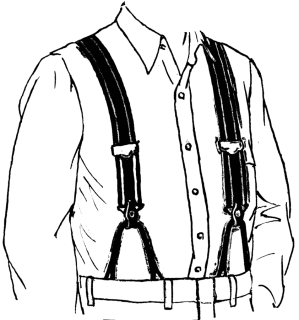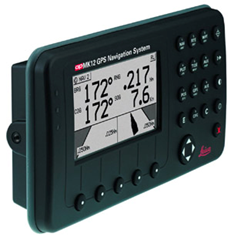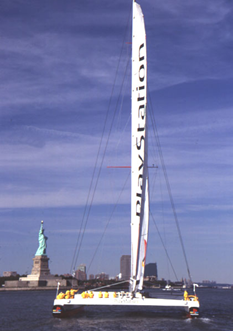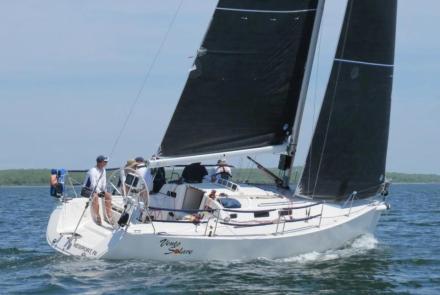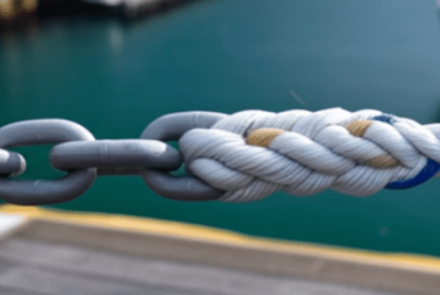Standing in the Way of Progress: Redundancy is not necessarily bad
“From the CCA School of Hard Rocks
...lessons learned in pursuit of the Art of Seamanship”
By Chuck Hawley, San Francisco Station
Aboard PlayStation, the mood was not excessively glum, but there was an air of disappointment. We’d crossed the Atlantic, west to east, in about 7 ½ days, making it the second fastest crossing under sail, but a day longer than the record set by Jet Service V, 11 years prior to our crossing. We consoled ourselves that the weather window was not as favorable as we had anticipated, and we had sailed a lot of extra miles to find the wind that’s necessary for a record-setting voyage.
|
Our track, in red, took us into the path of icebergs working their way S from the Labrador Sea. Jet Service V’s track is shown in blue. |
Now we were miles after the finish line, south of Lizard Head on England’s southwest coast, and we were heading down the Solent after dark, aiming for a rendezvous with a harbor tug that would tow us into Southampton Harbor. To reduce drag, the crew had removed the propellers, propeller shafts, and struts so that PlayStation’s hull was unencumbered with unnecessary bits that would slow us down. That meant that 105’ long, 60’ wide catamaran was truly a sailboat, albeit one that did not tack very well, was very difficult to sail slowly, and once stopped, was at the whim of the winds.
|
Leica GPS receiver, circa 2000. |
Stan Honey and I were in the navigation station in the starboard hull, providing navigational insights to the helmsman and crew on deck using a VHF radio. Stan was on the Panasonic ToughBook computer which displayed a large digital chart of the Solent, and which got its data from a Leica GPS which was mounted a few feet away. I was looking at a Furuno Radar, calling out targets as we ran down the river at 15-20 knots. On a clear day such speed would be normal; in pitch black darkness, it was a tad risky, but PlayStation was not easily slowed down. Traffic was nil, but occasionally I’d see something on the radar that wasn’t apparent on the chart, and we would call up to the helmsman and alert him to the possible vessel in his area.
After sitting next to Stan for about an hour, I stood up to stretch and get some blood flowing in my legs. As I did, I heard the faint but unmistakable snap of a circuit breaker going from the On to the Off position, followed by the sound of an alarm coming from the computer that was displaying the charts. “What happened to the GPS?” asked Stan as he looked at a message on the screen telling him that the GPS signal had been lost. I looked to my right, immediately adjacent to my shoulder, and saw the Leica GPS circuit breaker in the off position, which I had managed to flip when I stood up. “I think I turned off the Leica” I squeaked.[1]
Stan quickly reached over to a very small toggle switch on the nav station panel, and flipped a switch from a position labeled “Leica” to one labeled “Satcom C”. The alarm coming from the computer stopped almost immediately, and Stan said “Flip the GPS back on, would you?” We were back in operation in no more than 10 seconds. I sat down, embarrassed, and stared at my radar.
|
PlayStation in New York Harbor, sailing past a well-known monument. |
While it’s possible to have a spare everything on board your boat, with repair kits and filters and owner’s manuals and tools that you have long forgotten what they go to, there are certain items that need to be prioritized for the safe operation of the boat. One of the things on PlayStation that was entirely redundant was the navigation computer and its GPS data source. Since the Satcom C had an independent GPS and its own antenna, it made an ideal second source of GPS data for the Panasonic computer, which was one of two computers as well. Stan prioritized the safe navigation of the vessel, and didn’t want to be crawling around somewhere in the dark trying to figure out which two wires to connect should something fail. Those wires were already connected to a toggle switch and in seconds they solved the problem.
So, was this approach redundant? Most meanings of the word redundant are related to employment (he was redundant and therefore we let him go) or it means superfluous or more than enough. But it can mean “a back-up”, as in a back-up system for some critical function. Cars have redundant braking systems so that it’s extremely unlikely to lose all your braking ability. Disk drives are mirrored so that if one drive fails, the other is ready instantly to take over. And Stan chose to have a redundant source of GPS data in case his primary source was neutralized by a clumsy sailor. A wise move, as it turned out.
The Cruising Club of America is a collection of passionate, seriously accomplished, ocean sailors making adventurous use of the seas. All members have extensive offshore boat handling, seamanship, and command experience honed over many years. “School of Hard Rocks” stories, published by the CCA Safety and Seamanship Committee, are intended to advance seamanship and help skippers promote a Culture of Safety aboard their vessels
[1] It should be remembered that while our current GPS receivers get a fix in seconds, this was not always the case. The earliest consumer GPS receivers, like the Magellan 1000, took minutes to download the latest orbital data, and frequently couldn’t “see” enough satellites simultaneously such that it could get a 3D fix. The GPS constellation grew over time, rocket launch by rocket launch, until mariners and pilots could get a 3D fix all the time, anywhere in the world. Older GPS models also had fewer “channels” and could receive signals from a limited number of visible satellites, so they would try in vain to receive the satellites with the best geometry, then switch to a different satellite if the original one was obscured for some reason. The Leica GPS receiver on PlayStation might have taken as much as a minute to compute our position once it was powered up again; at 15 knots, that would have been a quarter of a mile in the Solent.


